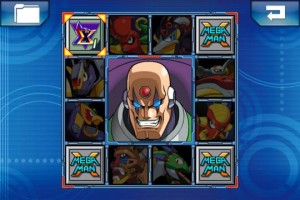Sometime in the year 20XX, the world renowned roboticist – Dr. Thomas Light – completed his greatest and final invention: an autonomous robot that he called X. Realizing all too well the danger his powerful machine could pose to the world if it chose the path of destruction, but not having the time left in his advancing age to perform the tests himself, the elderly scientist sealed the robot away in a capsule that would run a series of ethical testing on X’s artificial mind. The doctor had rightly predicted that he wouldn’t live long enough to see whether or not X was ready for the world, and the location of the capsule became lost along with the scientist’s passing.
 Many years later into the future – long after the testing had successfully completed – the capsule was discovered by Doctor Cain during an excavation effort, whom immediately became fascinated with the designs of X’s circuitry that were still ahead of their time. Copying these designs as best he could – even though he didn’t fully understand the work of his predecessor – Dr. Cain used what he learned from X to build the reploids, whom proved highly beneficial to humanity and immediately went into mass production. However – much as Thomas Light had originally feared when his first built X – soon these reploids began to rise up in rebellion against their human creators and wreaked havoc and carnage, leaving X with no choice but to stop the brethren robots that had been built based on his template.
Many years later into the future – long after the testing had successfully completed – the capsule was discovered by Doctor Cain during an excavation effort, whom immediately became fascinated with the designs of X’s circuitry that were still ahead of their time. Copying these designs as best he could – even though he didn’t fully understand the work of his predecessor – Dr. Cain used what he learned from X to build the reploids, whom proved highly beneficial to humanity and immediately went into mass production. However – much as Thomas Light had originally feared when his first built X – soon these reploids began to rise up in rebellion against their human creators and wreaked havoc and carnage, leaving X with no choice but to stop the brethren robots that had been built based on his template.
Thus begins the setup for the classic Megaman X (out now, $4.99), a high action platform jumping game released by Capcom – nearly two whole decades back in 1994 – originally for the highly venerated Super Nintendo Entertainment System. The game successfully brings all of the levels – and gameplay action – of the classic successfully to an iOS device, all while including passable control options such that you can operate the game almost as successfully as you did with the original game pad. Unfortunately, for reasons that I will both explain and cover much further down in the review, this port also manages to lose much of the visual effects panache of the original offering.
 Like all the Megaman titles before it – for those of you who are not already familiar with how the original game played – in Megaman X you are tasked with tracking down and defeating 8 master reploids, and afterwards the leader of the rebellion, acquiring each boss’s special weapon in the process. While you are openly free to tackle the first 8 stages in any order that you please – as well as later on replaying them in search of power up items you might have missed on the first go – there is a rock-paper-scissors strategy element to the game where each of the bosses is particularly weak to a specific weapon, thus making it beneficial to tackle the levels in the order where you always have the right tool for the job. Furthermore – unlike the original Megaman games that came before it – you can also perform running dashes and wall jumps in Megaman X, as well as find hidden armor upgrades that permanently enhance both X’s abilities and appearance.
Like all the Megaman titles before it – for those of you who are not already familiar with how the original game played – in Megaman X you are tasked with tracking down and defeating 8 master reploids, and afterwards the leader of the rebellion, acquiring each boss’s special weapon in the process. While you are openly free to tackle the first 8 stages in any order that you please – as well as later on replaying them in search of power up items you might have missed on the first go – there is a rock-paper-scissors strategy element to the game where each of the bosses is particularly weak to a specific weapon, thus making it beneficial to tackle the levels in the order where you always have the right tool for the job. Furthermore – unlike the original Megaman games that came before it – you can also perform running dashes and wall jumps in Megaman X, as well as find hidden armor upgrades that permanently enhance both X’s abilities and appearance.
With that out of the way, I want to happily say that – with some tweaking done to get the buttons arranged in a way that pleases you – you truly can find a virtual button layout that is almost as good as using an original SNES controller. There are a wide array of button layouts, all curiously hidden under the settings option labeled screen, that let you choose both how the buttons are distributed – such as diagonally, horizontally, or vertically apart from each other – as well as the order of the jump and shoot buttons in that arrangement. You furthermore have a plethora of options available to you for how dashing is executed, which include pressing the down button – pressing either the left or right button twice quickly – or having an extra on screen dash button added next to the jump and shoot buttons.
 The game also includes – in acknowledgement of the fact that simultaneously pressing multiple virtual buttons with the same hand is an impractical proposition – a wide variety of control tweaks, this time curiously located under the configuration section labeled cheats (especially odd since most of them are on by default). These modifications include the ability to have X’s arm cannon automatically rapid-fire whenever you hold down the shoot button, as opposed to having to repress the button for each and every shot, as well as having the arm cannon automatically charge whenever you’re not holding the button. Leaving all of these various toggles on will go a long way in making Megaman X a practical and enjoyable iOS experience, but I guess it’s also nice for strict purists that they can be turned off as well.
The game also includes – in acknowledgement of the fact that simultaneously pressing multiple virtual buttons with the same hand is an impractical proposition – a wide variety of control tweaks, this time curiously located under the configuration section labeled cheats (especially odd since most of them are on by default). These modifications include the ability to have X’s arm cannon automatically rapid-fire whenever you hold down the shoot button, as opposed to having to repress the button for each and every shot, as well as having the arm cannon automatically charge whenever you’re not holding the button. Leaving all of these various toggles on will go a long way in making Megaman X a practical and enjoyable iOS experience, but I guess it’s also nice for strict purists that they can be turned off as well.
Another iOS specific tweak that Capcom has seen fit to add to this port of Megaman X is the addition of a wide variety of real money based in-app purchases, but don’t start panicking just yet. Despite the fact that Capcom has purchasable unlocks for almost every single thing in the game – such as all of the armor pieces, all of the life bar extension hearts, as well as the special weapons themselves – Capcom has not modified the game in any way whatsoever in order to create an artificial need for those purchases. The list of in-app purchases available does – however – also include a complete replacement set of remixed music, it’s a truly refreshing change of pace to see a game with an IAP that actually offers a legitimate content expansion.
 Another change from the original game is that you can now save your progress directly, rather than being expected to constantly write down a password each and every time you wish to stop playing. However – unlike most iOS games – Megaman X does not automatically update the save file when something new happens, so you will lose all of your progress if you don’t manually hit the save button before you exit. On the other hand – though – the iOS port does let you save elements of progress that the original game never did, such as the acquisition of the secret one-hit kill Hadoken technique.
Another change from the original game is that you can now save your progress directly, rather than being expected to constantly write down a password each and every time you wish to stop playing. However – unlike most iOS games – Megaman X does not automatically update the save file when something new happens, so you will lose all of your progress if you don’t manually hit the save button before you exit. On the other hand – though – the iOS port does let you save elements of progress that the original game never did, such as the acquisition of the secret one-hit kill Hadoken technique.
One final odd game play tweak is that Capcom has added a variety of flip-screen like boundaries to the stages that were not originally there, which furthermore serve as artificial blockades against backtracking. Everything will be scrolling along normally in the game – just as it always did beforehand – until you suddenly hit a point where the motion stops, and these do not always occur in the most logical of places. While the addition of these artificial barriers will serve to rile up the ire of staunch traditionalists, they do have the nice perk of making checkpoints far more abundant in the game than they originally were back in the day.


